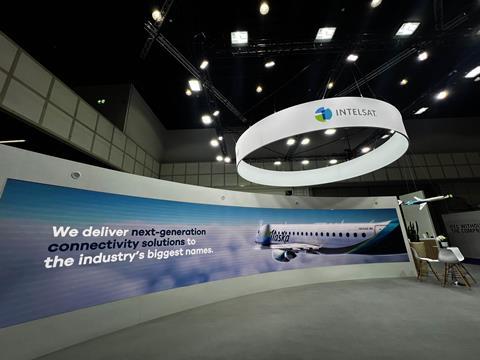While in-flight connectivity specialist Intelsat is paving the way to increased line-fit options for its new multi-orbit solution, it also sees requirement to meet updated customer expectations as helping to drive retrofit business from carriers looking to update their existing products.
Intelsat has during the AIX show outlined two more contract wins. On top of securing an order to equip 43 Airbus narrowbodies for German carrier Condor with its established Ku-band service, it has also won a notable deal from Japan Airlines to provide multi-orbit connectivity using its new electronically steered antenna (ESA) solution on more than 20 Boeing 737 Max jets.

The deal with JAL, already an Intelsat Ku-band service customer, is particular noteworthy as it will be among the first carriers to take Boeing aircraft line-fit equipped with the service.
Last September Intelsat became a line-fit option with Airbus for its multi-orbit connectivity solution – which utilises both LEO and GEO satellites – and is now in the process of creating line-fit at Boeing.
Speaking to FlightGlobal, Intelsat’s senior vice-president for commercial aviation, Dave Bijur, says: ”When you think of the line-fit business, any premium airline is going to order an airplane with in-flight internet; it’s just going to happen. And when they do they want the best thing money can buy them.
”It doesn’t mean they will indiscriminately buy them. But it means if a better option is available they will go for the best one. So by putting these new ESA terminals forward… it just creates a better option.”
He says the retrofit market is a bit different because in many cases there are connectivity systems in place that are 10-15 years old.
”We have systems on airplanes that have been there since before the iPhone existed. So put into perspective what the internet has done since then,” says Bijur. ”Before it was an email thing. But the internet has moved to a very high bandwidth consumptive experience and the [old] systems were built for the Internet we knew then. That’s what is really different from what we are building today.
”I think in the retrofit market you’ve got new product that is designed to deal with the 2024 Internet rather than the 2008 Internet and that’s a big driver for the retrofit. Most of the airplanes we are installing are upgrades, they are not what I call green aircraft.
Key customer wins for its ESA service alongside JAL include Air Canada and American Airlines, the latter in February detailing plans to retrofit nearly 500 regional jets with the service.
“So far we have signed up about 750 airplanes to that new system,” Bijur says. ”We will start installing them this summer and that’s very exciting for us.”
One of the benefits of the ESA antenna, that it is lighter, also taps into growing airline requirements to meet heightened sustainability goals.
”We are trying to create a system that is easy to maintain. High reliability is good for the planet and helps operators reduce their carbon footprint and those are things that matter for airlines. I can’t tell you how many of the RFPs I receive have a set of questions about the environmental impact of what we do. Those kind of things were never asked about 10 years ago.”
Intelsat comes into the show less than a month after satellite firm SES agreed a deal to acquire the company – a transaction which is expected to complete in the second half of 2025. It comes amid recent consolidation in the sector, such as Viasat’s acquisition of Inmarsat, while Intelsat had itself acquired the commercial aviation arm of Gogo in 2020.
”From a roadmap perspective, I think airlines are going to benefit from consolidation in the market,” says Bijur. ”We have seen it already. I think it creates stronger, more robust providers with greater footprint across the planet and the ability to serve customer demand.”


























